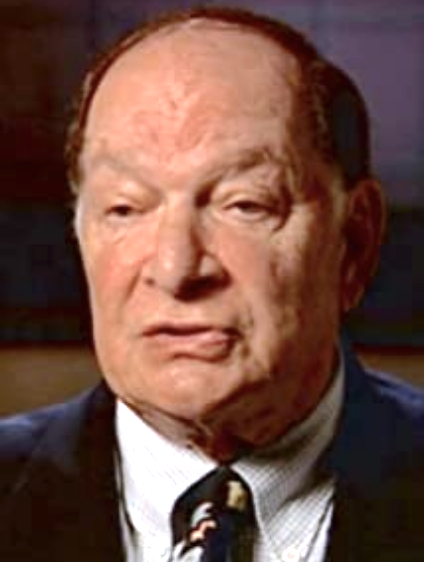On this date in 1926, Julian Weisel Scheer, who kept God off a plaque left on the moon in 1969, was born in Richmond, Va., to Hilda (Knopf) and George Scheer. He served in the U.S. Merchant Marine during World War II and after the war entered the University of North Carolina at Chapel Hill, graduating in 1950 with a degree in journalism and communications.
After working for a decade as a Charlotte News reporter, Scheer started working as a consultant for NASA at the end of the Mercury program in 1962 to create an organizational framework for NASA’s public relations efforts. In early 1963 he became NASA’s assistant administrator for public affairs. He strived to make the public more aware of the program while making flight technicians and astronauts more available for interviews. “The program was really a battle in the Cold War, and Julian Scheer was one of its generals,” astronaut Frank Borman later said. (Washington Post, Sept. 3, 2001)
In preparation for the historic Apollo 11 mission in July 1969 with commander Neil Armstrong, command module pilot Michael Collins and lunar module pilot Edwin “Buzz” Aldrin, Scheer helped craft the message on a plaque that would be attached to a leg of the lunar module’s descent stage, which would land and remain in an area of the moon called the Sea of Tranquility.
Scheer drafted the text for the plaque as a member of NASA’s Committee on Symbolic Activities for the First Lunar Landing. It said: “HERE MEN FROM THE PLANET EARTH FIRST SET FOOT UPON THE MOON. JULY 1969, A.D. WE CAME IN PEACE FOR ALL MANKIND. President Nixon’s and the astronauts’ names and signatures were under the statement.
According to several accounts, including Scheer’s, Nixon wanted God mentioned. Rocket Men: The Epic Story of the First Men on the Moon by Craig Nelson (2009), recounts Scheer telling Nixon aide Peter Flanigan at the White House in early June that not everyone worships the same god after Flanigan tried to insert “under God” after “We came in peace,” with Nixon initialing his approval of the change.
That flew in the face of Scheer’s wish that the plaque should make a universal statement: “Peter [Scheer said], there is no universal god.” Flanigan: “Dammit, Julian, the president wants that change. The president is big on God. … Billy Graham is here nearly every Sunday. The president wants God on the plaque!”
Scheer, in a 1989 column he wrote for the Orlando Sentinel, said NASA administrator Thomas Paine asked him on the way back from the White House what he was going to do. “The plaque has been put on the spacecraft and checked out,” Scheer replied. “I guess the answer is nothing.” Paine answered, “I didn’t hear that.”
William Safire, a speechwriter for Nixon and Vice President Spiro Agnew at the time, later wrote in his New York Times column (July 17, 1989) about reviewing the inscription submitted by NASA: “We left ‘July 1969 A.D.’ intact because it was a shrewd way of sneaking God in [certainly not NASA’s intent]: the use of the initials for anno Domini, ‘in the year of our Lord,’ would tell space travelers eons hence that earthlings in 1969 had a religious bent; piously, we made sure that a Bible with both Testaments was included in the spacecraft’s cargo.” Safire also suggested “came in peace” should replace the original “come” and it was.
About six months earlier, on Dec. 24, 1968, the Apollo 8 crew (Bill Anders, Jim Lovell and Frank Borman) had read verses 1-10 from the Book of Genesis that were broadcast back to Earth while orbiting the moon. Scheer wasn’t involved with writing the text of what the astronauts read (drafted by Borman’s journalist friend Joe Laitin and his wife Christine). Scheer slyly told a Japanese journalist staying at a Houston hotel who was looking for the transcript: “Open the drawer of the table next to your bed. In it you will find a book. Turn to the first page. The words you are looking for are there.” (Chasing the Moon: The People, the Politics, and the Promise That Launched America Into the Space Age by Alan Andres and Robert Stone.) The book was a companion to the 2019 three-episode PBS “American Experience” documentary. The mission’s religious intrusion was later upheld by the 5th Circuit U.S. Court of Appeals, with the Supreme Court declining to take the case.
After the successful Apollo 11 mission, Scheer was awarded NASA’s highest award, the Distinguished Service Medal, and led the crew on tours around the world. He left NASA in 1971 to manage the campaign for Terry Sanford (D-N.C) for the presidency but remained a consultant to the space program and was a trustee of the Smithsonian Institution’s National Air and Space Museum. He worked for a Washington-based communications consulting firm until 1976, when he became a vice president running the Washington offices of LTV Corp., whose holdings include steel mills.He retired from LTV in 1992 and returned to his consulting firm. He wrote several books, including Light of the Captured Moon for children.
He married Virginia Williams and they had three children before divorcing. After his death at age 75 of a heart attack, he was survived by his wife of 36 years, the former Suzann Huggan, with whom he had a daughter. D. 2001.


